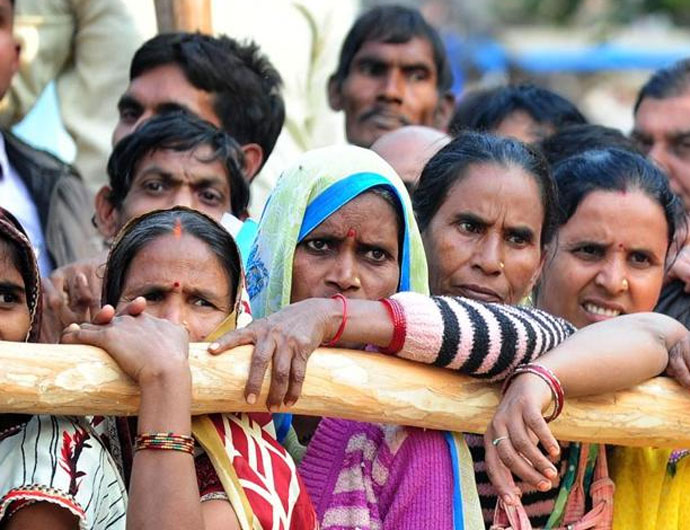How long before the demonetisation drought dries up India's villages?

"Hope springs eternal in the human breast," English poet Alexander Pope would have said looking at the people standing in queues in front of banks and ATMs.
More than a month after demonetisation, people are still queuing up for cash with hope that there will be light at the end of the tunnel.
Hope is dashed too. Politics, especially of the populist variety, kindles hope as fast as it kills. There is darkness at the end of the tunnel when it happens.
There are visible signs of despair in the middle class, lower-middle class and the poor as time goes by. With cash still in acute short supply and people’s miseries not abating, there are unmistakable signs of distress turning into despair.
Despair has not yet reached the tipping point. It may even take much longer than expected for people to lose patience and reach that inflection point.
Poor people have nothing else but hope to live on. They have lost faith in the system. They have felt cheated, have seen promises made and broken so may times that they have learnt to live with the system they know is thoroughly corrupt and made to serve the rich and the powerful.
Demonetisation has rekindled the poor’s hope for something better. People are willing to wait. But the question is for how long?
 |
| Banks play no role in running the village economy. |
There are tell-tale signs of people slowly coming out of the dream the demonetisation scheme has weaved. People are gradually coming to terms with the hard reality.
North India is reeling under severe winter. People sit in groups around fire in villages to beat the cold. They are talking about ruined agriculture and loss of income from sources such as milk and vegetable sales and small business.
They are talking about the promises the prime minister has made to them to fill their coffers from the money taken away from the black money hoarders and tax dodgers. They think the this pain is a precursor to the money to be deposited in their accounts.
It’s difficult to question faith. They believe the government has begun a war against the greed and avarice of the corrupt and the rich. They will continue to believe until they realise their hope was misplaced; that they have been cheated once again.
However, there are also some cynical and carping voices rising to cast doubt over the benefits of the scheme. Such voices can rise to make themselves audible if the promised gains of demonetisation fail to materialise.
Winter is the time of migration from and to villages. Some migrate at this time of the year to places that offer better employment opportunities and enhanced wages. Some also head back home to lend hands to their families in sowing and harvesting.
But this year there is only reverse migration. Workers having lost jobs in the cities. Self-employed, lower middle classes having lost their businesses are returning to their villages.
 |
| People are willing to wait. But the question is for how long? |
They are returning empty-handed. Unlike in the past when they returned with clothes and goods for their children and parents, and with sarees and cosmetics for their wives, this year they have nothing but their grief and plight to share.
Almost every family in the village has one or more members working in the cities to shoulder or share the family responsibilities. Demonetisation has dried up the sources of income at both ends.
Not merely workers, students are returning in droves because they haven’t received the monthly bank transfer. Villages that faced shortage of labour are teeming with working hands but there is no work for them.
It’s common in villages to run debts for various reasons. Some borrow money to buy seeds and pesticides, some incur debt for a wedding in the family and education of children; and most of them are forced to borrow to meet medical needs.
Prime Minister Narendra Modi, who claims to have sold tea for living, should know how the village economy works.
Banks play no role in running the village economy. Even where banks are present, they don’t lend to the poor and small farmers. They don’t lend to the self-employed, who are engaged in small family businesses such as cycle repair shops, teashops, small roadside eateries and groceries shops.
Banks don’t lend without collaterals. It’s a messy business pursuing farmers when crops fail or when calamities such as drought and flood affect productivity, which happens very often.
Moneylenders fill in the place for banks. They charge interest rates from minimum of 36 per cent to anything up to 48 per cent. Yet, large number of people depend for their needs on moneylenders. That source of income too has dried up.
Even worse is the plight of the people who had already borrowed from moneylenders before the currency withdrawal. Those who had mortgaged their land to borrow at frightfully high interests rates for emergency needs can’t pay back any time soon. The interest is piling up multiplying the borrowers’ miseries.
People who had incurred debts are in dire straits. Those who need cash are in dire straits.
Yet people have so far put up with difficulties in hope for a better future. They still hope Modiji will transform their lives with the magic wand of demonetisation.
Anybody who thinks that people’s hope is eternal is mistaken. Those who think that hope has already been translated into votes for the BJP in UP and elsewhere are mistaken.
Hope is turning into despair and anger. There are ominous signs for Modiji.

